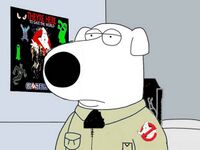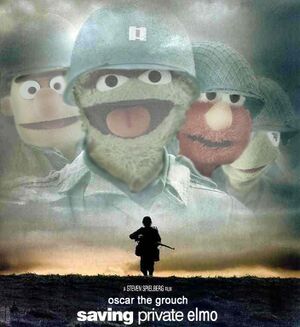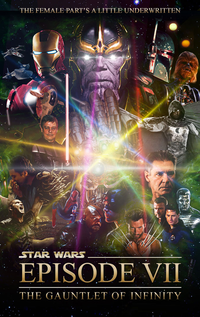Cinematic universe
A Cinematic universe is a visible second dimension filled with various characters. It once had been a beautiful art form dating back thousands of years, but now solely exists to entertain humans with expendable income. It is not to be confused with a sequel (a recycled repeat from the original material) or a crossover (an underused cinematic universe). In order to help keep the lights on at dying movie theatre outlets, you can expect to see more in the future. This article will help you recognise a Cinematic Universe, as well as provide numerous examples to differentiate between first, second and third waves in this popular medium.
Before the Cinematic-Era (2400BCE-1BCE)[edit]
Early History[edit]
In Ancient Greece, a man called "Yogan" bored of watching his slaves suffer carrying unreasonable loads, first conceived the idea. He drew some stick figures on the inside of a crapply-made pot full of holes and placed a candle on the bottom. When he lit the candle, spun the potter's wheel and stared into the holes in the pot, the little figure would jump up and down. Over time, "Yogan" made many of these pots, but the same characters stuck around as he couldn't draw. Eventually, by the 30th pot or so, Tall man (or woman) and horse teamed up to star in Person rides horse. This astonishing invention would have absolutely no bearing on history. Alexander the Great[1] ruined the collection one night celebrating a victorious battle by filling them with acidic wine. That is why is why we call moving films, as it comes from the Greek word Kilms meaning "Kill it with fire".
Scientific Rediscovery[edit]
Initially, the professors at Harvard had no intention of researching the possibility of 2-dimensional universes. In the 1950s, this changed as the television became more common in British Households, curiosity of intelligent beings to exist on the screen became stronger. Some of the physicists who weren't making any headway with String Theory, shifted their focus to this. The search slowly narrowed down over the odd weekend thanks to large microscopes. Due to the electron microscope only being invented in 1975, the most strangest contraption made of cogs and glass lenses occupied most of the Department. It was so heavy it broke the 2nd floor and had to be relocated to the 3rd floor [2].
First Contact[edit]
A connection with a sub-dimensional species happened when a new shinny class 2B laser was shone throughout the microscope during a system check. The intelligent beings used a glowing substance and by turning it on and off, were able to catch the attention of the professors. Nothing could be exchanged between the parties, records show that Harvard professors began making falsified reports about the language and conversations. Stories that emerged apparently revealed that these 2-D beings could jump into multiple 3-D realities, giving a wealth of shareable tales. However, some writing and plot parallels between Isaac Asimov and the 2-D beings can suggest that this endeavour was a hoax. Communication seized 5 months later, due to a higher wattage laser incinerating the 2-D colony. All findings then mysteriously transferred to the Social Science Library archives, before being sold off at a book fair in the late 20th. Purchased by none other then a picture company that specialised in universe creation, Universal Studios.
The Big Bang Reboot (0BCE-0ACE)[edit]
Initial Attempt[edit]
Using the knowledge throughout this book, Universal Studios created the original 2-D universe after reclassifying their earlier movies - named the Universal Monsters Universe. Using public domain properties, they had created a film franchise spanning several decades. The first being The Hunchback of Notre Dame and Phantom of the Music Play airing in the 1920s. Most of the well-known movies were not produced until the 1930s, which included Frankenstein along with his son and bride, Dracula, a vampire hunter, someone wrapped up in toilet paper, Invisible Man and a dog. These movies - while mostly in colour - mostly had a 'dark' horror tone, which allowed the studio to hide the universe's existence from other corporations. Of course, the historical wars being fought around this time may have also shielded it away from the public eye. The earliest mention of it's Working title 'Dark Universe' only arose in the 2010s. This may be false to due a comedic duo called Abbott and Costello who lead the first manned dimensional journey into this universe and noted in their documentary series Abbott and Costello Meet the Monsters[3] that they were relatively harmless.
Near the end of this universe's run, the producers pitched various monsters against each other. It all started when one of producers had gotten into an argument with her friend over who would would win in a fight, Frankenstein or Wolf Man. This archaic Batman V Superman, unsurprisingly flopped as both monsters didn't survive the flood after the dam where they were filming unexpectedly collapsed. It took two other attempts before they finally moved back to doing one-shot monster stories. After the airing of the Leach Woman, films of other genres seemed to be taking off so they quietly left it. It would be a while till they would come back to this format and it is currently unknown if there will ever be another one.
Marvel's Innovation[edit]
In the late 90s through to the early 00s, Marvel was amidst selling its intellectual property to film studios. The finance department got increasingly concerned that giving lengthy licences with a ton of characters wasn't sustainable. So it was unanimously agreed that such a deal like the Mutant sell-off wouldn't happen in the future. This rule was accidentally broken when the company sold off Spiderman, this hero and all his memorable villains would not be seen inside Marvel's universe until Sony's universe stabiliser broke after too many reboots. In 1999, during negations on the new Hulk movie with Universal studios a Marvel Intern was chatting to the Universal Manager about the recent Brendan Fraser Mummy movie. He was surprised to discover that the movie was actually taken from the defunct Cinematic Universe and asked if he could see it. Armed with his new founded knowledge of the device's construction, he generated one in his garage and filled it with Marvels remaining properties. This became the basis of a multi-million dollar patent, due to processor and graphics enhancements it was vastly superior to the clunky original from Universal. While it could only give about one to two movies on average per year (compared to Universal's which could do five to six per year on average), they could be produced with high quality and uncanny digital special effects. By 2005, Marvel Studios LLC began the process of producing the films for the general audience. Many other film companies would attempt to create their own Cinematic Universes with varying degrees of success (see below). Disney - who had been scratching their heads - went quote "it is too hard" and acquired Marvel for its one in 2009.
After the Cinematic-Era (1ACE-?)[edit]
After this fantastic innovation, it become extremely easy to document the existence of a Cinematic Universe. The following CU's are classified in terms of waves and the Content Aware Scale (CAS) is used to measure the audience recognition threshold. This information has gathered from the Large Dimensional Array Scanners Alpha[4], Beta[5], Messa[6] and armchair critics. Currently this section is undergoing more research from these primary sources and will be completed soon.
First Wave: Original ideas
After Universal Studios reclassified their works and generated the first Cinematic Universe, another archaic version had to be reclassified as well. The True Story Universe, which featured retellings of historical events in Earth’s History. It is still up for debate if inspired true stories are a part of this universe, as there have been allegations that they are retold differently to the source material. This not to be confused with based on true stories as they only update the components of the story, so the audience can follow it.
After Marvel announced its universe, Doctor Who performed a similar method using age-old spin-off theory to push this trend. This did not completely lead to a cinematic universe as both shows Sarah Jane Adventures (school children dealing with alien threats) and Torchwood (a team dealing with illegal aliens that come out of a rift to earth) suffered a temporal collapse. A reboot was attempted a little later, but due to memory corruption the successor Class (school children dealing with aliens that come through a rift) wasn’t successful.
First Wave Universes can be identified by their focuses being given mainly to the story at hand and give small nods to the unifying universe, it sits close to zero on the CAS.
Second Wave: Externalised Focus
The Second Wave of the Cinematic Universe is similar to First Wave, the only difference being with its rating, which sits at a high 600 to 3,000 on the CAS. To understand why this is the case, we will take a moment to view the history behind it.
This wave begun to rise in popularity after Marvel’s highly-anticipated Avengers movie. The movie brought a lot of characters established in previous cinematic universe stories and understandably interest was lost between this movie and the next Avengers instalment. Director Joss Whedon was the first of many film makers who was tasked in forcing the Cinematic Universe to reference and set up future movies in the next Avengers instalment. This left regular movie goers who saw the movie confused due to not having extensive background of the universe, past and future.
David Attenborough, the narrator for Fantastic Beasts and Where to Find Them had been brought in to stop the CAS from limiting potential newcomers from viewing the Harry Potter Cinematic Universe (HPCU). While this did increase viewership, this has not stopped newer works from being bogged down in the previous ones, or vice versa. Fans discovered within the Cinematic Universes’ source code, Ugandan wizards and witches could cast magic with their hands, a patch that was later added after the main story. As a result, Harry Potter and the Cursed Child was unable to be produced to film, in part thanks to the patches’ bugs introduced into the Cinematic Universe and had to made into a theatre play.
Even though there is a high CAS threshold for this wave, it is only for people have not watched any other similar content previously. Research into the second wave movies has shown that CAS limits are reduced if far more related content is consumed, but some participants were perfectly fine with not knowing what was going on[7].
Third and Final Wave: Monetary Priority
The Monetary Priority Wave is considered by many to be the last configuration of cinematic universe generation. First wave came from the ingenuity to tell a story, the second refers to previous material, but the third comes from money itself – this is not necessarily terrible. It can be argued that both second and first waves require money to pay various people to ensure the project is done. Merchandising the movie can assist poor, hungry employees become the opposite. This usually works by lifting a character’s render code from the Cinematic Universe and 3-D printed before being packaged for stores.
The movies in this wave have not been created using company-funded Cinematic Universe programs. Open-source software has been substituted to save costs, the money is not redistributed to programmers to attempt to heavily modify source code. The money will usually be routed into making the film aesthetically pleasing, but some producers believe that the cost savings allow them freedoms in other areas. A prime example is the Ghostbusters CU being rebooted in 2016 from the Legacy version to the Upgraded to Cinematic Universe System Ver 4.0. This allowed the director to record copious amounts of footage and retakes, costing a unprecipitated level in electricity and overtime. The problem with this wave was first discovered during audience testing, with CAS scores ranging from normal positive values to abnormal negative values. These abnormal negative values are associated with – but not limited to – audience dissatisfaction, slow neural growth rates and boycotting future related products.
With the introduction of newer third wave universes from Hasbro Toys, Call of Duty and Hanna-Barbera, a far deadlier problem has been uncovered.
Cinematic Universe Determination Questionare[edit]
When determining if the piece of media is part of a Cinematic Universe, ask yourself the following important questions:
- How many YouTube channels cover it? (Usually a dead giveaway)
- Does the film have a cinematic counterpart?
- Does the book have a cinematic counterpart or is it an equivalent?
- Does the TV show have another cinematic counterpart?
- Does the game tie-in with another cinematic counterpart? (It could be possibly promotional material.)
- Does the media piece rely on past media knowledge?
- Does the media start with a non-cinematic production company?
- Do other people discuss the media as part of a non-linear series?
- Are there many different big-league actors participating?
- Is there a lot CGI?
- Are the viewing theatres packed in the first week of release?
- Is there a post credit scene?
- Is there a mid-credit scene, along with a post credit scene?
- Does it have a Spinoff Lego Video Game?
- Are three or more Pop Culture references made?
If there are any Red Flags raised from the questions above, it is highly likely that you are unknowingly witnessing the birth of an unholy creation that will plague you for the years to come.
The Multiverse Movie Probability[edit]
“One should always be a little improbable.”
The number of movies being added day by day, month by month, year by year. It is has been theorised by the writer(s) of this Article that the probability of crossovers will occur in an inconceivable amount one day. This terrible day is inevitable as all copyrighted works shuffle much closer and closer to their grave in the public domain. Big companies such as Disney has delayed this somewhat by explaining to the Courts that too many knock-off DisneyLands would pop up, causing an economic collapse due to revenue reduction. Viacom, along with gaming giants enforce copyright claims on YouTube to censor anything that may surface. VR creators are hurriedly trying to create a better virtual world where this possibility is removed entirely. It truly depends on when all Movie Theatres go out of business due to online store sales[8].
Footnotes[edit]
- ↑ A. Great Bender (1993) p. 69 by Historian Alex Perkins
- ↑ Structural Nightmares (1962), p. 98-120 by FirstName LastName
- ↑ Abbott and Costello Meet the Monsters Collection, 1981. [DVD] Charles Barton, Charles Lamont, America: Universal Studios.
- ↑ Metacritic.com. (2017). Metacritic - Movie Reviews, TV Reviews, Game Reviews, and Music Reviews. [online]
- ↑ Rottentomatoes.com. (2017). Rotten Tomatoes: Movies | TV Shows | Movie Trailers | Reviews. [online]
- ↑ IMDb. (2017). IMDb - Movies, TV and Celebrities. [online]
- ↑ Fanservice serves which fans?: A look into Movie References (2011), by Marvel Scientists
- ↑ No more shopping centres: A world with Online Stores (Current Year) by Wikipedia





